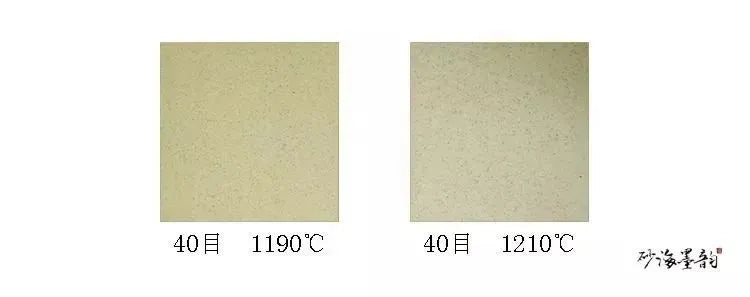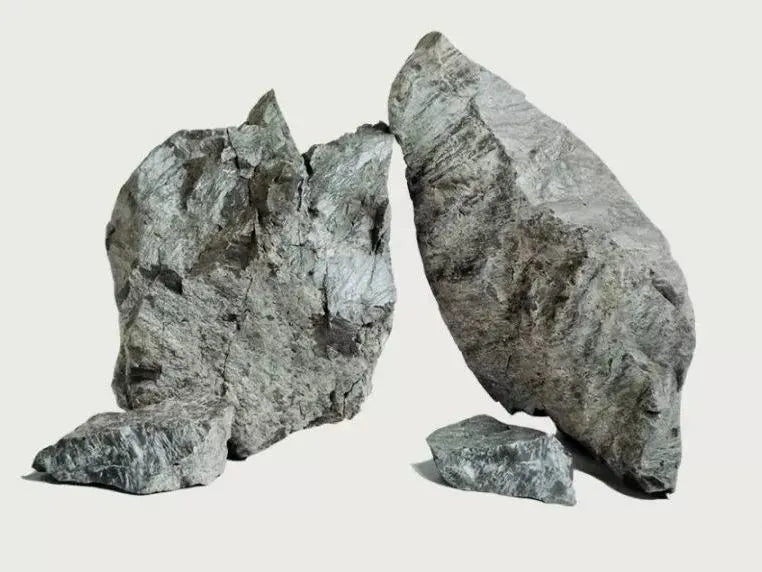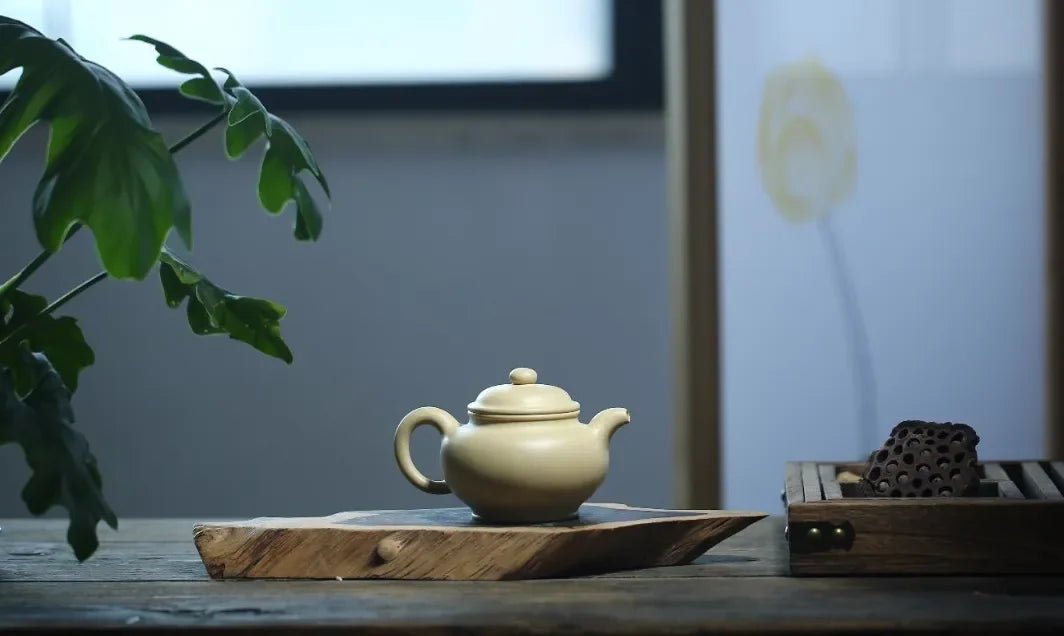Green clay, also known as "Benshan green clay", is named according to the place of origin and the color of the original ore. The color of the clay resembles the skin of mung beans, light grass green. The texture of the pot made from it is simple, the sand is fine and rich in granular beauty. The color of the pot is beige with a hint of green, and gradually turns into a warm and bright color after soaking. The patina is good and easy to soak, and it emits a faint green light.

Green clay is produced in the Huanglongshan ore vein in Dingshu, Yixing. It is a relatively high-quality clay material in the Duan clay category. Compared with the Benshan Duan clay in a single sense, the original ore clay does not contain purple clay components, the iron oxide content is low, there are few black particles after firing, and the pottery is yellow in different shades.
The green clay in different mining areas also has different performances.
Today, I will analyze the green clay in each mining area for you.
1. Green mud from No. 4 well

Appearance of the original ore: The appearance of the ore is uniform and fine, light green and dense, slightly hard, and rusty on the surface.
Shrinkage: about 4%.
Firing color: After firing, it is light yellow-green, the body is fine and smooth, and the color is pure and smooth.

2. Red hemp seed green mud

Occurs occasionally in the ore layer, with very little mineral content.
Ore appearance: The ore material is light gray-green, dense and blocky, slightly hard. Because it contains more red pitting, it is vividly called "red pitting" green mud by miners.
Shrinkage rate: about 4.5%.
Firing color: After firing, it is beige, with dense black sand particles in the body, the surface of the vessel is smooth and lustrous, and the color effect is extremely rich.

3. Sesame Green Mud from Well No. 4

It is produced 52 meters below the level of the No. 4 mine.
Appearance of the original ore: The appearance of the ore is light green, dense and blocky, slightly hard, with light black cloud-like patterns on the ore. Because there are many black sand particles in the body after firing, it is usually called "sesame green mud".
Shrinkage rate: about 5.5%.
Firing color: After firing, it is slightly dark light yellow, the body is fine and smooth, and the color effect is very rich.

4. Green mud in Taixi mining area

Produced in the open-pit mine of Taixi Village.
Appearance of the original ore: The appearance of the ore is light green and dense, slightly hard, with a rusty surface, and some of the ore has dark purple-red clouds.
Shrinkage: about 7%.
Firing color: After firing, it is yellow, the body is pear-skin-like, the sand is fine and bright, and the color effect is delicate and rich.
After a certain high temperature firing, it is light green;
After firing in a weak reducing atmosphere at a certain temperature, it is light goose yellow, and the purple-red and black particles in the body are also clearer.

5. Taixi Sesame Green Mud

Produced in the open-pit mine of Taixi Village.
Appearance of the original ore: The appearance of the ore is slightly dark green and dense, brittle and not hard, containing slightly more fine white mica fragments, and the cross section is slightly coarse sand. Because there are more and more obvious black sand particles in the body after firing, it is usually called "sesame green mud".
Shrinkage rate: about 5%.
Firing color: After firing, it is slightly dark yellow, the body is fine and smooth, but the surface is slightly dry, and the appearance color purity is slightly poor.
As the firing temperature increases, it gradually turns bluish black.

6. Taixi Shallow Surface Green Mud

Produced in the interlayer of tender purple mud layer, sometimes the upper layer is gravel layer.
Ore appearance: The appearance of the ore is light gray-green dense block, fragile and not hard, with rust, embroidery and gray-white mesh on the ore.
Shrinkage rate: about 6.5%.
Firing color: After firing, it is light yellow and slightly green, the body is relatively firm, and the surface particles are slightly pear-skin-like, and the color is pure and warm.

7. Green mud in Baoshan mining area

Produced in the lower part of the tender purple mud layer, it is usually only a few centimeters thick and contains very little minerals.
Appearance of the original ore: The appearance of the ore is light gray-green and dense, brittle and not hard, with rust on the surface.
Shrinkage rate: about 8%.
Firing color: After firing, it is light green-yellow, the body is firm and smooth, with a fine pear-skin surface, with a little black particles, and the color effect is relatively rich.

8. Baoshan Jiangpo green mud

Produced during the construction of Huanglongshan Leisure Plaza.
Appearance of the original ore: The appearance of the ore is green and dense, brittle and not hard, with purple-red stripes on the surface formed by the red mud layer on the slope. After firing, it will bring a slightly reddish color to the body;
Shrinkage rate: about 5%.
Firing color: After firing at different temperatures, it will be yellow, dark yellow, dark green and yellow. The body particles have a good texture.

9. Baoshan Jiangpo sesame green mud

Produced in the lower ore layer of Baoshan Industrial Park.
Appearance of the original ore: The appearance of the ore is green and dense, slightly hard, with rust on the surface and purple-red stripes formed by the red mud layer at the bottom, and the cross section is slightly coarse sand. Because there are more and more obvious black sand particles in the body after firing, it is usually called "sesame green mud".
Shrinkage rate: about 6%.
Firing color: After firing, it is yellow with a slight green tint, the body has a strong texture, the texture is rough but not rough, and the color is pure and warm.

10. Baoshan Sesame Green Mud

Appearance of the original ore: The appearance of the ore is gray-green dense block, slightly hard, with rust and white wax on the surface, and slightly coarse sand in cross section. Because there are more and more obvious black sand particles in the body after firing, it is usually called "sesame green mud".
Shrinkage rate: about 5.5%.
Firing color: After firing, it is light yellow with a slight green tint. The body has a strong texture, but the surface is relatively dry and the appearance is slightly less moist.

11. Qinglongshan Green Mud

Appearance of the original ore: The appearance of the ore is light gray-green dense block, slightly hard, and there are light gray-yellow flakes on the ore.
Shrinkage rate: about 6%.
Firing color: After firing, it is yellow, the color is relatively pure, the body particles have a good texture, but the surface is slightly dry. As the temperature rises, it gradually turns green.

12. Taixi Sesame Dark Green Mud

Produced in the open-pit mine of Taixi Village, the mineral content is relatively low.
Appearance of the original ore: The appearance of the ore is light gray dark green dense block, relatively hard, containing slightly more fine white mica fragments, dark purple and ink spots and mottled on the ore, and rust on the surface. Because the body contains more and more obvious black sand particles after firing, it is usually called "sesame green mud";
Shrinkage rate: about 3%.
Firing color: After firing, it is light yellow, the body is pure and warm, and the color effect is relatively rich.

13. Dark green mud in the shallow surface of Taixi

Produced in the interlayer of mixed mud layer, the mineral content is very small.
Appearance of the original ore: The appearance of the ore is gray-dark green dense block, slightly hard, and the surface is black. Because there are more and more obvious black sand particles in the body after firing, it is usually called "sesame green mud".
Shrinkage rate: about 4%.
Firing color: After firing, it is light yellow and slightly green, the body particles are hidden, the surface is smooth and moist, and the color effect is delicate and rich.
The higher the firing temperature, the more green the hue appears.

14. Qinglongshan Sesame Dark Green Mud

Appearance of the original ore: The appearance of the ore is gray-dark green and dense, and the cross section is dark yellow-green and slightly hard. The ore has discoloration caused by oxidation and other factors.
Shrinkage rate: about 5%.
Firing color: After firing, it is yellow, the body particles have a strong texture, the color is relatively pure, but the surface is slightly dry.

15. Baoshan Jiangpo Dark Green Mud

Appearance of the original ore: The appearance of the ore is light gray dark green dense block, brittle and not hard, with iron red rust flakes in the ore, black, white waxy and purple-red spots formed by the red mud layer below the slope;
Shrinkage rate: about 5.5%;
Firing color: After firing, it is bright yellow with a slight green, the body is fine and firm, the pear skin-like surface shows black particles, and the color effect is delicate and rich.

16. Baoshan Dark Green Mud

Appearance of the original ore: The appearance of the ore is dark green and dense, brittle and not hard, with rust and flakes on the surface.
Shrinkage: about 5.5%.
Firing color: After firing, it is light yellow, the appearance is good, but the black sand particles in the body are slightly messy. After a certain local temperature, it is light green and yellow.

17. Baoshan Sesame Dark Green Mud

Appearance of the original ore: The appearance of the ore is gray-dark green and dense, which is fragile and not hard. Because the body contains more and more obvious black sand particles after firing, it is usually called "sesame green mud".
Shrinkage rate: about 6.5%.
Firing color: After firing, it is light yellow, the surface granular texture is strong, the body is pure and warm, and the color effect is relatively rich.


